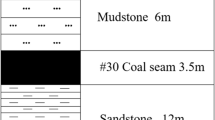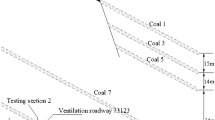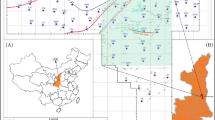Abstract
This paper investigates the pressure-relief response of the floor in top slice mining, taking No. 2 coal seam in **ta coal mine as its engineering background. The failure laws of the lower slice along strike and with depth during the top slice mining process are analyzed with comprehensive methods including theoretical calculation, similar simulation, and numerical simulation. It is found that physical experiments on similar materials and numerical simulation with FLAC3D software using a Mohr–Coulomb model give comparable results, both indicating that floor destruction in the top slice reaches a depth of about 20 m. The empirical formula is found to be non-applicable for predicting the depth of damage in the top slice when mining an extra-thick seam. It is further shown that the lower slice is able to restrict floor failure. In the mining direction, the distribution and change characteristics of stress are highly correlated with the periodic weighting: the range over which stress recovery occurs in the floor after periodic weighting is about 0.6 times that before periodic weighting. The conclusions are of engineering significance for the accurate arrangement of gas drainage boreholes and the avoidance of mine gas disasters. On the basis of all the rules, the practical application of gas drainage of the lower slice was carried out, which is beneficial for coal mining and economic achievements at the same time.










Similar content being viewed by others
References
Adhikary DP, Guo H (2014) Measurement of longwall mining induced strata permeability. Geotech Geol Eng 32(3):617–626
Aguado MBD, Nicieza CG (2007) Control and prevention of gas outbursts in coal mines, Riosa-Olloniego coalfield. Spain. Int J Coal Geol 69(4):253–266
Cao SG, Zou DJ, Bai YJ et al (2012) Study on upward mining of sublevels for gob-side entry retaining in three-soft thin coal seam group. J Min Saf Eng 29(03):322–327
Chen XZ (2004) Soil mechanics and geotechnical engineering. Tsinghua University Press, Bei**g
Cheng YP, Wang L, Liu HY et al (2015) Definition, theory, methods, and applications of the safe and efficient simultaneous extraction of coal and gas. Int J Coal Sci Technol 2(1):52–65
Fan L, Liu S (2017) A conceptual model to characterize and model compaction behavior and permeability evolution of broken rock mass in coal mine gobs. Int J Coal Geol 172:60–70
Hu WY, Yin SX (2010) Dynamic mechanism of water inrush from floor of mining face. Chin J Rock Mech Eng 29(S1):3344–3349
Huang QM, Wu B, Cheng WM et al (2018) Investigation of permeability evolution in the lower slice during thick seam slicing mining and gas drainage: a case study from the Dahuangshan coalmine in China. J Nat Gas Sci Eng 52:141–154
Jiang YD, Lv YK, Zhao YX et al (2011) Similar simulation test for breakage law of working face floor in coal mining above aquifer. Chin J Rock Mech Eng 30(8):1571–1578
Li S, Fan CJ, Han J et al (2016) A fully coupled thermal-hydraulic-mechanical model with two-phase flow for coalbed methane extraction. J Nat Gas Sci Eng 33:324–336
Liu XS, Tan YL, Ning JG et al (2015) The height of water-conducting fractured zones in longwall mining of shallow coal seams. Geotech Geol Eng 33(3):693–700
Liu SL, Li WP, Wang QQ (2018) Height of the water-flowing fractured zone of the Jurassic coal seam in northwestern China. Mine Water Environ 37:312–321
Meng XR, Xu CH, Gao ZN (2010) Stress distribution and damage mechanism of mining floor. J China Coal Soc 35(11):1832–1836
Meng ZP, Wang BY, Xu LW, Wu ZY, Bai G, Lu BT (2012) Influence of coal mining on the deformation-failure and permeability of seam floor. Coal Geol Explor 40(02):39–43
Meng ZP, Shi XC, Li GQ (2016) Deformation, failure and permeability of coal-bearing strata during longwall mining. Eng Geol 208:69–80
Qian MG, Shi PW (2003) Mining pressure and strata control. China University of Mining and Technology Press, Xuzhou, pp 188–190
Shi LQ, Xu DJ, Qiu M et al (2013) Improved on the formula about the depth of damaged floor in working area. J China Coal Soc 38(S2):299–303
Suchowerska AM, Merifield RS, Carter JP (2013) Vertical stress changes in multi-seam mining under supercritical longwall panels. Int J Rock Mech Mining Sci 61:306–320
Tan YL, Ning JG, Li HT (2012) In situ explorations on zonal disintegration of roof strata in deep coalmines. Int J Rock Mech Min Sci 49:113–124
Wang JH (2013) Key technology for fully-mechanized top coal caving with large mining height in extra-thick coal seam. J China Coal Soc 38(12):2089–2098
Wang H (2015) Gas control technology for first slice working face of complicated extra thick coal seam in Baijigou mine. Min Saf Environ Prot 42(06):77–79 + 82
Wang LG, Han M, Wang ZS et al (2013) Stress distribution and damage law of mining floor. J Min Saf Eng 30(3):317–322
Wang G, Li WX, Wang PF et al (2016a) Deformation and gas flow characteristics of coal-like materials under triaxial stress conditions. Int J Rock Mech Min Sci 91:72–80
Wang W, Cheng YP, Yuan L et al (2016b) Floor fracture evolution and relief gas drainage timeliness in deeper underground short-distance upper protective coal seam extraction. J China Coal Soc 1:138–148
Wang G, Wu MM, Wang R et al (2016c) Height of the mining-induced fractured zone above a coal face. Eng Geol 216:140–152
Wu JW, Fan C (2003) Study on in situ measurement of water-resisting ability of coal seam floor rock mass. Chin J Geotech Eng 25(1):67–70
**ao FK, Duan LQ, Ge ZH (2010) Laws of floor break in coal mining face and gas extraction application. J China Coal Soc 35(03):417–419
Xu JL, Wang XZ, Liu WT, Wang ZG (2009) Effects of primary key stratum location on height of water flowing fracture zone. Chin J Rock Mech Eng 28(02):380–385
Yuan L (2015) Theory and practice of integrated coal production and gas extraction. Int J Coal Sci Technol 2(1):3–11
Zhang JC, Liu TQ (1990) The depth and the distribution characteristics of the theory of coal floor fractured zone. J China Coal Soc 15(2):46–55
Zhang HL, Wang LG (2011) Computation of mining induced floor additional stress and its application. J Min Saf Eng 28(2):288–292
Zhang R, Jiang ZQ, Yue ZC et al (2012) In-situ dynamic observation and numerical analysis of thick coal seam floor’s failure law under the mining. J Min Saf Eng 29(5):625–630
Zhang R, Jiang ZQ, Li XH et al (2013) Study on the failure depth of thick seam floor in deep mining. J China Coal Soc 38(01):67–72
Zhang C, Tu SH, Zhang L (2016) A methodology for determining the evolution law of gob permeability and its distributions in longwall coal mines. J Geophys Eng 13(2):181–193
Zhao YX, Jiang YD, Lv YK et al (2013) Similar simulation experiment of bi-directional loading for floor destruction rules in coal mining above aquifer. J China Coal Soc 38(03):384–390
Zhu SY, Jiang ZQ, Yao P et al (2007) Application of analytic method in calculating floor stress of a working face. J Min Saf Eng 24(2):191–194
Zhu SY, Cao DT, Zhou HY et al (2014) Restrictive function of lithology and its composite structure on deformation and failure depth of mining coal seam floor. J Min Saf Eng 31(1):90–96
Acknowledgements
This research was financially supported by National Nature Science Foundation of China (No. 51274205).
Author information
Authors and Affiliations
Corresponding author
Additional information
Publisher's Note
Springer Nature remains neutral with regard to jurisdictional claims in published maps and institutional affiliations.
Rights and permissions
About this article
Cite this article
Liu, S., Huang, J., Huang, Q. et al. Floor Pressure-Relief During Top Slice Mining of Extra-Thick Coal Seams and Its Implications for Gas Drainage Application. Geotech Geol Eng 37, 3113–3125 (2019). https://doi.org/10.1007/s10706-019-00828-x
Received:
Accepted:
Published:
Issue Date:
DOI: https://doi.org/10.1007/s10706-019-00828-x




